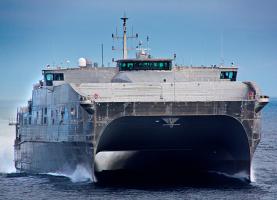 The Littoral Combat Ships (LCS) are not the only small new Navy ships with serious operating deficiencies. Recently, the Department of Defense Office of the Inspector General released a report on the shortcomings of a new class of fast, shallow draft, transport ship, the Expeditionary Fast Transport (EPF), ordered by the Navy. In addition to being over budget, the aluminum catamaran vessels are slower and have less range than designed. They also cannot transfer vessels at sea in waves much larger than a ripple. Also, the ships have cybersecurity flaws which could potentially allow hackers to disable or take control of the ship’s systems.
The Littoral Combat Ships (LCS) are not the only small new Navy ships with serious operating deficiencies. Recently, the Department of Defense Office of the Inspector General released a report on the shortcomings of a new class of fast, shallow draft, transport ship, the Expeditionary Fast Transport (EPF), ordered by the Navy. In addition to being over budget, the aluminum catamaran vessels are slower and have less range than designed. They also cannot transfer vessels at sea in waves much larger than a ripple. Also, the ships have cybersecurity flaws which could potentially allow hackers to disable or take control of the ship’s systems.
The Navy ordered 12 EPF ships from Austal USA, the shipyard which is also building the Independence Class LCS. So far eight of the EPF have been delivered with four more under construction. The EFT ships were inspired by the design of the two Hawaiian “Superferries.” The ferries were not a commercial success, getting embroiled in legal and environmental concerns. One of the ferries was taken over by the US Navy and is now operating as the USNS Guam, while the second ferry is operating in scheduled service between Portland, Maine and Yarmouth, Nova Scotia. The EPF ships are said to share 70 percent in common with the Hawaii Superferries, both built by Austal USA.
So, what problems do the ferries have? In 2014, the USNS Spearhead, the first of the EPF class, suffered serious bow damage when crossing the Atlantic. The broad flat underside of the aluminum catamaran hull cost over a half a million dollars to repair. The rest of the EPF ships were retrofitted with stronger bow structure at a cost ranging from $300,000 to $1.2 million a ship.
In the Commander, Operational Test and Evaluation Force (COMOPTEVFOR) report issued April 24, 2018, it is clear that there are other serious problems with the ships, as well. The EPF are designed to carry 1.2 million pounds, 600 short tons, of cargo a distance of 1,200 nautical miles at a speed of 35 knots. With that cargo load, however, the ships were found to be able to operate for 858 nautical miles at an average speed of 31 knots.
The ships were also supposed to be able to transfer vehicles at sea using a stern ramp in waves of up to 1.25 meters high. In operation, the ships could only do ship-to-ship transfers in waves of .3 meters.
And then there is cybersecurity. The report comments: Cybersecurity vulnerabilities could potentially lead
to hackers disabling or taking control of systems, preventing the EPF vessel from accomplishing its missions. According to a DoD Cybersecurity Instruction, if cybersecurity risk management is not adequately addressed during the initiation, development, and acquisition phases of the system development life cycle, these tasks will be undertaken later in the life cycle and will be more costly and time consuming to implement.
What is to be done? The report addresses that directly, saying, “Navy officials may have to spend additional money to achieve the required performance capabilities for EPF vessels that were already provided to the fleet and for future EPF vessels that are still in production.”
The $2 billion project is currently $77 million over budget, with apparently more red ink to come.
Thanks to Roberta Weisbrod for contributing to this post.

Not surprised. There was a ferry of similar design here in Frenchman’s Bay. It tried to operate between Bar Harbor Maine and Nova Scotia. Its biggest problem? The couldnt keep the 4 diesel engines running. According to lacals, they were lucky if Cat Ferry would have two engines that would still be operational after one trip!
I never trusted Wikipedia data, but they state: Speed: 43 knots (80 km/h; 49 mph)
https://en.m.wikipedia.org/wiki/USNS_Trenton_(T-EPF-5)
As of Feb. 2017, they built 8 of 12 hunks of junk!
Who designed this crap ship?
BIW might not see
more work as Navy
steers toward 355-ship
fleet
BATH — When then-
candidate Donald Trump
came to Lisbon in the
closing days of the 2016
presidential campaign, he
promised additional work
for Bath Iron Works in
the form of new ship
construction
http://www.sunjournal.com/biw-might-not-see-more-work-as-navy-steers-toward-355-ship-fleet/
BIW has been downsized for some time now. What with the littoral junk being made elsewhere.